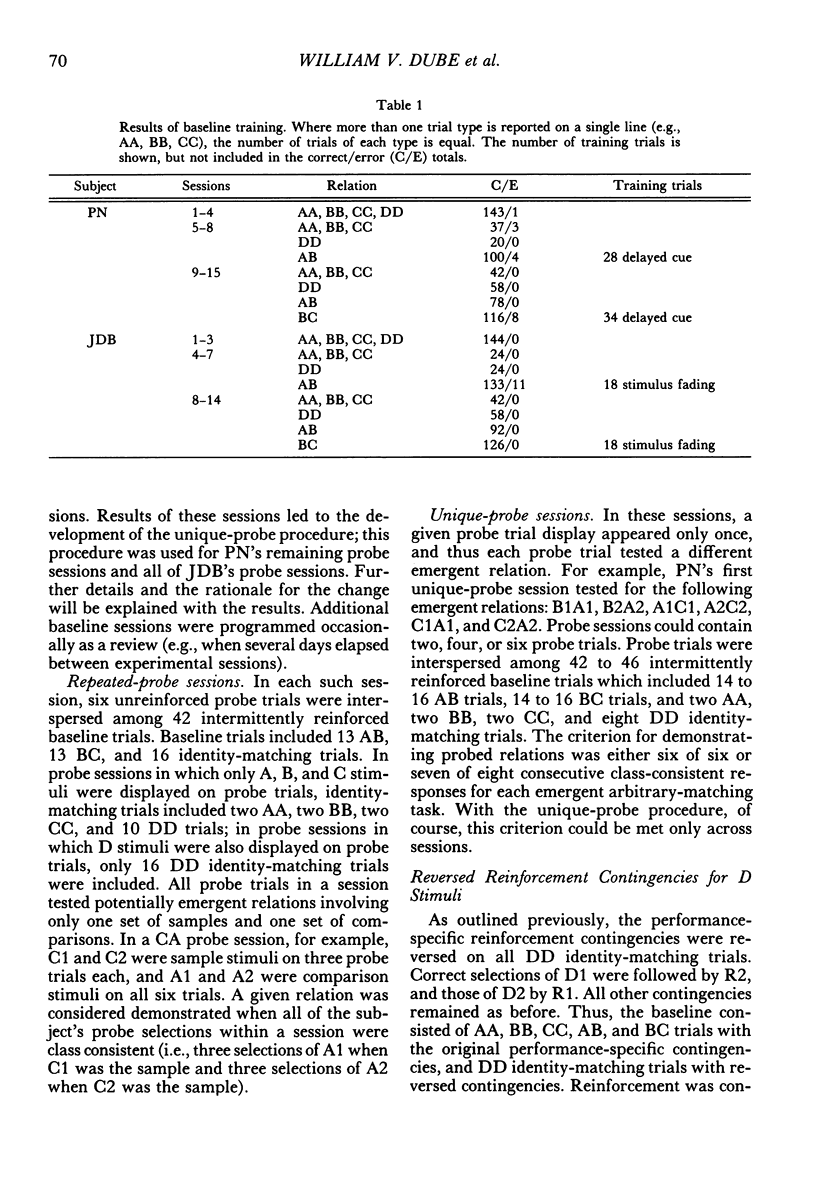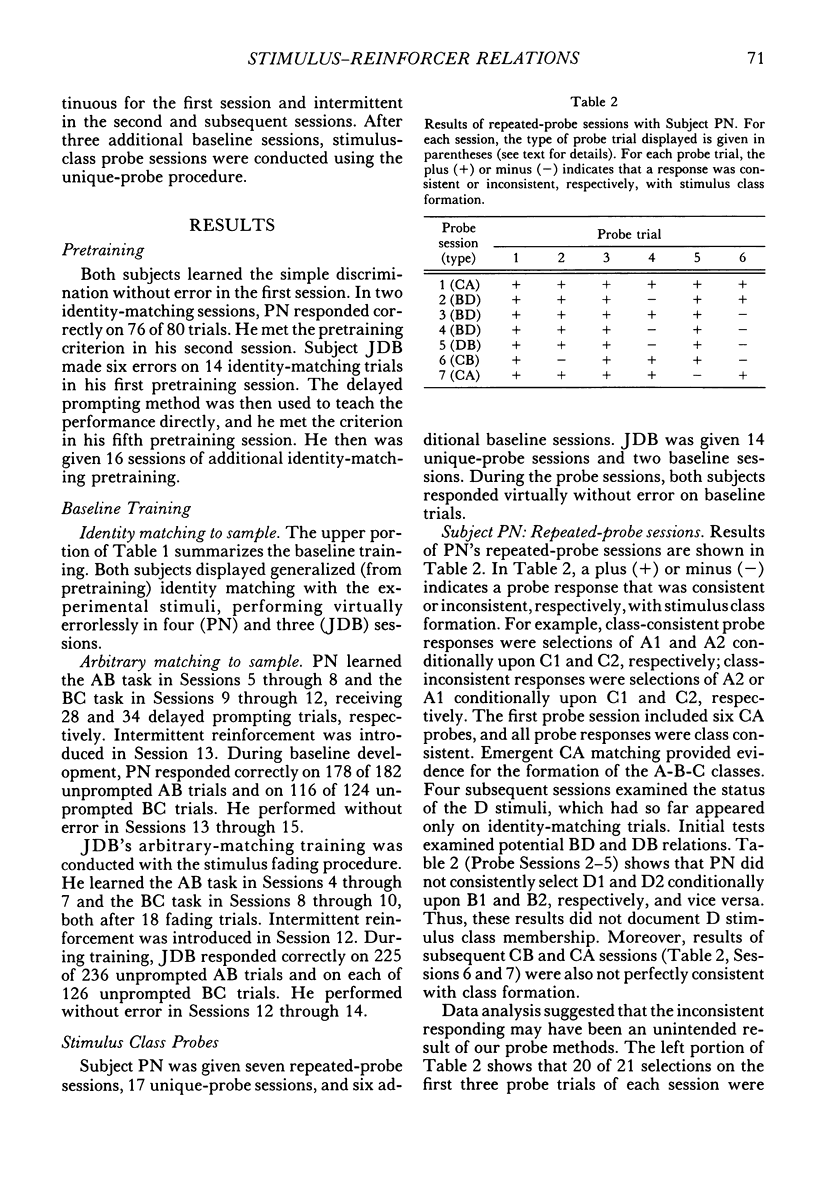Abstract
This study examined stimulus class membership established via stimulus-reinforcer relations. Mentally retarded subjects learned conditional discriminations with four two-member sets of visual stimuli (A, B, C, and D). On arbitrary-matching trials, they selected comparison stimuli B1 and B2 conditionally upon samples A1 and A2, respectively, and C1 and C2 conditionally upon B1 and B2, respectively. On identity-matching trials, they selected all stimuli as comparisons conditionally upon identical stimuli as samples. Throughout training, correct selections of A1, B1, C1, and D1 were followed by one reinforcer, R1, and those of A2, B2, C2, and D2 were followed by another, R2. Subsequent tests documented the formation of two four-member stimulus classes, A1-B1-C1-D1 and A2-B2-C2-D2. The class membership of the A, B, and C stimuli could have been based on equivalence relations that resulted from the arbitrary-matching training. D1 and D2 had never appeared on arbitrary-matching trials, however. Their class membership must have been based on relations with R1 and R2, respectively. Results thus confirm a previous finding that stimulus classes can be expanded via stimulus-reinforcer relations. They also define more precisely the potential nature of those classes and the conditions under which class membership can be established.
Full text
PDF











Selected References
These references are in PubMed. This may not be the complete list of references from this article.
- Dube W. V., McIlvane W. J., Mackay H. A., Stoddard L. T. Stimulus class membership established via stimulus-reinforcer relations. J Exp Anal Behav. 1987 Mar;47(2):159–175. doi: 10.1901/jeab.1987.47-159. [DOI] [PMC free article] [PubMed] [Google Scholar]
- Fields L., Verhave T. The structure of equivalence classes. J Exp Anal Behav. 1987 Sep;48(2):317–332. doi: 10.1901/jeab.1987.48-317. [DOI] [PMC free article] [PubMed] [Google Scholar]
- Galloway C., Petre R. D. An analysis of the functional equivalence of stimulus class members. J Exp Child Psychol. 1968 Sep;6(3):384–390. doi: 10.1016/0022-0965(68)90119-7. [DOI] [PubMed] [Google Scholar]
- Lamarre J., Holland J. G. The functional independence of mands and tacts. J Exp Anal Behav. 1985 Jan;43(1):5–19. doi: 10.1901/jeab.1985.43-5. [DOI] [PMC free article] [PubMed] [Google Scholar]
- McIlvane W. J., Kledaras J. B., Munson L. C., King K. A., de Rose J. C., Stoddard L. T. Controlling relations in conditional discrimination and matching by exclusion. J Exp Anal Behav. 1987 Sep;48(2):187–208. doi: 10.1901/jeab.1987.48-187. [DOI] [PMC free article] [PubMed] [Google Scholar]
- Rescorla R. A. Pavlovian conditioning and its proper control procedures. Psychol Rev. 1967 Jan;74(1):71–80. doi: 10.1037/h0024109. [DOI] [PubMed] [Google Scholar]
- Saunders R. R., Saunders K. J., Kirby K. C., Spradlin J. E. The merger and development of equivalence classes by unreinforced conditional selection of comparison stimuli. J Exp Anal Behav. 1988 Sep;50(2):145–162. doi: 10.1901/jeab.1988.50-145. [DOI] [PMC free article] [PubMed] [Google Scholar]
- Sidman M., Tailby W. Conditional discrimination vs. matching to sample: an expansion of the testing paradigm. J Exp Anal Behav. 1982 Jan;37(1):5–22. doi: 10.1901/jeab.1982.37-5. [DOI] [PMC free article] [PubMed] [Google Scholar]
- Stromer R., Osborne J. G. Control of adolescents' arbitrary matching-to-sample by positive and negative stimulus relations. J Exp Anal Behav. 1982 May;37(3):329–348. doi: 10.1901/jeab.1982.37-329. [DOI] [PMC free article] [PubMed] [Google Scholar]
- Touchette P. E. Transfer of stimulus control: measuring the moment of transfer. J Exp Anal Behav. 1971 May;15(3):347–354. doi: 10.1901/jeab.1971.15-347. [DOI] [PMC free article] [PubMed] [Google Scholar]
- Wulfert E., Hayes S. C. Transfer of a conditional ordering response through conditional equivalence classes. J Exp Anal Behav. 1988 Sep;50(2):125–144. doi: 10.1901/jeab.1988.50-125. [DOI] [PMC free article] [PubMed] [Google Scholar]
- de Rose J. C., McIlvane W. J., Dube W. V., Galpin V. C., Stoddard L. T. Emergent simple discrimination established by indirect relation to differential consequences. J Exp Anal Behav. 1988 Jul;50(1):1–20. doi: 10.1901/jeab.1988.50-1. [DOI] [PMC free article] [PubMed] [Google Scholar]


